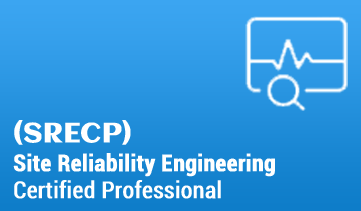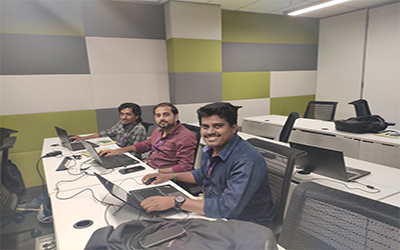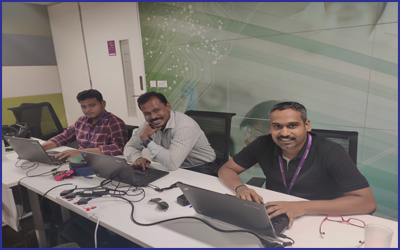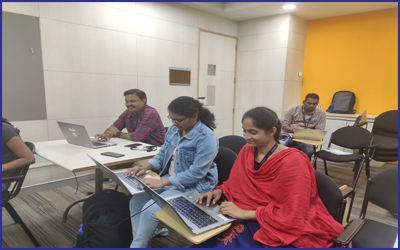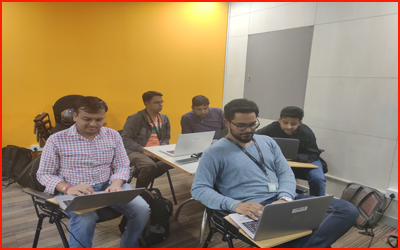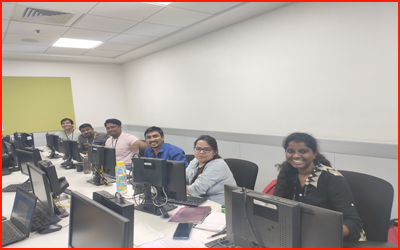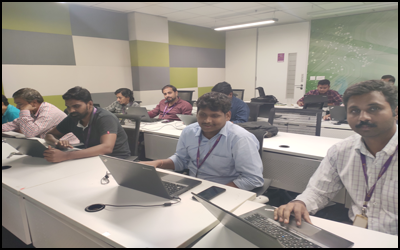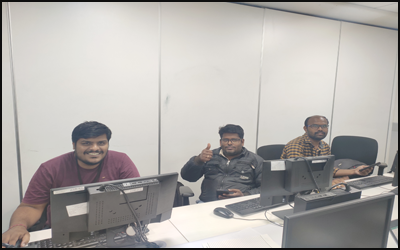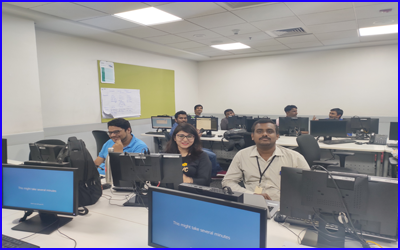SRE Certified Professional (Training & Certification)
Course Duration
69 hours
Live Project
01
Certification
Industry recognized
Training Format
8000+
Certified Learners
15+
Years Avg. faculty experience
40+
Happy Clients
4.5/5.0
Average class rating
An Introduction of SRE Training and Certification Program
Site Reliability Engineering Certified Professional (SRECP) is the world’s most advanced and comprehensive training cum certification program for aspiring Site Reliability Engineers, proudly offered by DevOpsSchool. This program is meticulously designed to equip participants with deep knowledge of SRE principles, modern operational excellence, automation-first practices, and real-world implementation strategies trusted by top global tech companies.
Unlike generic certification programs, SRECP combines live, instructor-led training with hands-on labs, real case studies, and future-ready tooling to help you master everything from SLIs/SLOs and error budgets to incident response, observability, resilience engineering, and chaos testing. It also provides comprehensive exposure to tools like Prometheus, Grafana, OpenTelemetry, Kubernetes, Terraform, Istio, PagerDuty, and more — carefully selected based on the evolving SRE landscape of 2025–2030.
Whether you're an experienced DevOps engineer looking to evolve into an SRE role or an operations leader aiming to implement reliability practices across your organization, SRECP offers the most practical, scalable, and globally recognized SRE education available today. Join the program and become a certified expert in building systems that are scalable, resilient, secure, and maintainable — with confidence backed by the world-class training only DevOpsSchool delivers.
Instructor-led, Live & Interactive Sessions
DURATION |
MODE |
PRICE |
ENROLL NOW |
|---|---|---|---|
69 Hrs (Approx) |
Self learning using Video |
14,999/- |
|
69 Hrs (Approx) |
Live & Interactive in Online Batch |
49,999/- |
|
69 Hrs (Approx) |
One to One Live & Interactive in Online |
99,999/- |
|
2 - 3 Days (Approx) |
Corporate (Online/Classroom) |
Contact US |
Calendar |
What is Site Reliability Engineering (SRE)?
Site Reliability Engineering (SRE) is a discipline that incorporates aspects of software engineering and applies them to infrastructure and operations problems. The main goals are to create scalable and highly reliable software systems. According to Ben Treynor, founder of Google's Site Reliability Team, SRE is "what happens when a software engineer is tasked with what used to be called operations."
About the Site Reliability Engineering Certified Professional (SRECP)
The Site Reliability Engineering Certified Professional (SRECP) is an industry-leading certification program offered by DevOpsSchool, designed to validate and advance your expertise in modern SRE practices. This program focuses on imparting a strong foundational understanding of SRE vocabulary, principles, and engineering methods that improve reliability, scalability, and efficiency across the software delivery lifecycle.
This training cum certification program provides deep insights into the theory and practical application of Service Level Objectives (SLOs) — a structured approach to defining and measuring service reliability. Learners will gain the skills necessary to design their first SLOs based on real services within their organization, promoting better alignment between engineering teams and business goals.
Participants will also explore how to use Service Level Indicators (SLIs) to quantify system reliability and apply Error Budgets to balance innovation with stability. The course includes hands-on guidance in crafting meaningful SLIs and SLOs, ensuring professionals can apply these principles effectively to drive operational excellence and reliability-focused decision-making.
What is Advantage of SRECP certification?
A Site Reliability Engineering Certified Professional (SRECP) Engineer is a professional who understands the principles of performance evaluation and prediction to improve product/systems safety, reliability and maintainability.
The SRECP program stands out as the most comprehensive and future-ready certification for anyone looking to build a solid foundation in Site Reliability Engineering. Unlike traditional programs that focus solely on theory, SRECP blends practical implementation with real-world tools and use cases — ensuring professionals not only understand the concepts, but are also capable of applying them in live production environments. With its hands-on approach, expert-led training, and alignment with the latest industry standards, this program equips learners with the core competencies required to succeed as an SRE in any modern DevOps or cloud-native organization.
How to become Site Reliability Engineering Certified Professional?
Please contact contact@DevOpsSchool.com
What you would Learn?
You'll learn:
- How to run reliable services in environments you don't completely control-like cloud
- Practical applications of how to create, monitor, and run your services via service level objectives
- How to convert existing ops teams to SRE-including how to dig out of operational overload
- Methods for starting SRE from either greenfield or brownfield
Agenda of the Site Reliability Engineering Certified Professional? Download Curriculum
- Let’s Understand about Software Development Model
- Overview of Waterfall Development Model
- Challenges of Waterfall Development Model
- Overview of Agile Development Model
- Challenges of Agile Development Model
- Requirement of New Software Development Model
- Understanding an existing Pain and Waste in Current Software Development Model
- What is DevOps?
- Transition in Software development model
- Waterfall -> Agile -> CI/CD -> DevOps -> DevSecOps
- Understand DevOps values and principles
- Culture and organizational considerations
- Communication and collaboration practices
- Improve your effectiveness and productivity
- DevOps Automation practices and technology considerations
- DevOps Adoption considerations in an enterprise environment
- Challenges, risks and critical success factors
- What is DevSecOps?
- Let’s Understand DevSecOps Practices and Toolsets.
- What is SRE?
- Let’s Understand SRE Practices and Toolsets.
- List of Tools to become Full Stack Developer/QA/SRE/DevOps/DevSecOps
- Microservices Fundamentals
- Microservices Patterns
- Choreographing Services
- Presentation components
- Business Logic
- Database access logic
- Application Integration
- Modelling Microservices
- Integrating multiple Microservices
- Keeping it simple
- Avoiding Breaking Changes
- Choosing the right protocols
- Sync & Async
- Dealing with legacy systems
- Testing
- What and When to test
- Preparing for deployment
- Monitoring Microservice Performance
- Tools used for Microservices Demo using container
Linux OS & Administration
- Understanding Linux Distributions (Ubuntu, CentOS, RHEL)
- Linux Boot Process and System Architecture
- Installing Linux on VirtualBox / Bare Metal
- Accessing Linux via Terminal, SSH, and TTY
- File System Hierarchy and Navigation (/, /etc, /var, /home)
- User and Group Management (adduser, passwd, groups)
- Permissions, Ownership (chmod, chown, umask)
- Package Management (apt, yum, dnf, snap)
- Process Management (ps, top, htop, kill)
- Service Management with systemd (systemctl)
- Log Files and Journald (journalctl, /var/log/)
- Mounting Disks and USBs (mount, fstab)
- Networking Basics (ip, ifconfig, netstat, ss)
- Firewall & SELinux Basics (ufw, firewalld, semanage)
- Crontab and Scheduled Jobs
- Linux File Search and Text Processing (find, grep, awk)
- Archiving and Compression (tar, gzip, zip, unzip)
- Disk Usage and Quota Management (df, du, quota)
Linux Shell Scripting
- Introduction to Shells (bash, sh, zsh)
- Writing Your First Bash Script
- Script Permissions and Execution
- Variables and User Input
- Conditional Statements (if, else, elif)
- Loops (for, while, until)
- Case Statements
- Functions in Shell Scripts
- Working with Arguments and Return Values
- Reading Files in Scripts
- Logging Script Output
- Debugging Shell Scripts (set -x, bash -x)
- Automating System Tasks (backup, logs, monitoring)
- Script Scheduling with Crontab
- Interactive Scripts with Menus and Colors
- Best Practices for Writing Maintainable Scripts
- Creating a Library of Reusable Shell Scripts
- Real-World Examples: User Management, Log Rotation, Auto Backups
- Introduction of AWS
- Understanding AWS infrastructure
- Understanding AWS Free Tier
- IAM: Understanding IAM Concepts
- IAM: A Walkthrough IAM
- IAM: Demo & Lab
- Computing:EC2: Understanding EC2 Concepts
- Computing:EC2: A Walkthrough EC2
- Computing:EC2: Demo & Lab
- Storage:EBS: Understanding EBS Concepts
- Storage:EBS: A Walkthrough EBS
- Storage:EBS: Demo & Lab
- Storage:S3: Understanding S3 Concepts
- Storage:S3: A Walkthrough S3
- Storage:S3: Demo & Lab
- Storage:EFS: Understanding EFS Concepts
- Storage:EFS: A Walkthrough EFS
- Storage:EFS: Demo & Lab
- Database:RDS: Understanding RDS MySql Concepts
- Database:RDS: A Walkthrough RDS MySql
- Database:RDS: Demo & Lab
- ELB: Elastic Load Balancer Concepts
- ELB: Elastic Load Balancer Implementation
- ELB: Elastic Load Balancer: Demo & Lab
- Networking:VPC: Understanding VPC Concepts
- Networking:VPC: Understanding VPC components
- Networking:VPC: Demo & Lab
- What is Containerization?
- Why Containerization?
- How Docker is good fit for Containerization?
- How Docker works?
- Docker Architecture
- Docker Installations & Configurations
- Docker Components
- Docker Engine
- Docker Image
- Docker Containers
- Docker Registry
- Docker Basic Workflow
- Managing Docker Containers
- Creating our First Image
- Understading Docker Images
- Creating Images using Dockerfile
- Managing Docker Images
- Using Docker Hub registry
- Docker Networking
- Docker Volumes
- Deepdive into Docker Images
- Deepdive into Dockerfile
- Deepdive into Docker Containers
- Deepdive into Docker Networks
- Deepdive into Docker Volumes
- Deepdive into Docker Volume
- Deepdive into Docker CPU and RAM allocations
- Deepdive into Docker Config
- Docker Compose Overview
- Install & Configure Compose
- Understanding Docker Compose Workflow
- Understanding Docker Compose Services
- Writing Docker Compose Yaml file
- Using Docker Compose Commands
- Docker Compose with Java Stake
- Docker Compose with Rails Stake
- Docker Compose with PHP Stake
- Docker Compose with Nodejs Stake
- Planning - Discuss some of the Small Project Requirement which include
- Login/Registertration with Some Students records CRUD operations.
- Design a Method --> Classes -> Interface using Core Python
- Fundamental of Core Python with Hello-world Program with Method --> Classes
- Coding in Flask using HTMl - CSS - JS - MySql
- Fundamental of Flask Tutorial of Hello-World APP
- UT - 2 Sample unit Testing using Pythontest
- Package a Python App
- AT - 2 Sample unit Testing using Selenium
Technology Demonstration
- Software Planning and Designing using JAVA
- Core Python
- Flask
- mySql
- pytest
- Selenium
- HTMl
- CSS
- Js.
- Introduction of Git
- Installing Git
- Configuring Git
- Git Concepts and Architecture
- How Git works?
- The Git workflow
- Working with Files in Git
- Adding files
- Editing files
- Viewing changes with diff
- Viewing only staged changes
- Deleting files
- Moving and renaming files
- Making Changes to Files
- Undoing Changes
- - Reset
- - Revert
- Amending commits
- Ignoring Files
- Branching and Merging using Git
- Working with Conflict Resolution
- Comparing commits, branches and workspace
- Working with Remote Git repo using Github
- Push - Pull - Fetch using Github
- Tagging with Git
- What is SonarQube?
- Benefits of SonarQube?
- Alternative of SonarQube
- Understanding Various License of SonarQube
- Architecture of SonarQube
- How SonarQube works?
- Components of SonarQube
- SonarQube runtime requirements
- Installing and configuring SonarQube in Linux
- Basic Workflow in SonarQube using Command line
- Working with Issues in SonarQube
- Working with Rules in SonarQube
- Working with Quality Profiles in SonarQube
- Working with Quality Gates in SonarQube
- Deep Dive into SonarQube Dashboard
- Understanding Seven Axis of SonarQube Quality
- Workflow in SonarQube with Maven Project
- Workflow in SonarQube with Gradle Project
- OWASP Top 10 with SonarQube
Gradle
- What is Gradle?
- Installing and Configuring Gradle
- Gradle Project Structure
- Build Java and C++ Projects
- Build Python Project with Plugins
- Dependency Management
- Gradle Tasks and Lifecycle
- Custom Build Scripts
- Using Gradle Plugins
- Gradle Properties and Profiles
PIP
- What is PIP?
- Installing Python Packages
- Understanding requirements.txt
- Creating Virtual Environments
- Using pip freeze and pip list
- Publishing Python Packages
- Using setup.py and pyproject.toml
- Installing from Git or Local Source
- Managing Package Versions
- PIP vs Poetry vs Conda
GitHub Packages
- What is GitHub Packages?
- Supported Formats: npm, Maven, Docker, PyPI, NuGet
- Publishing Packages to GitHub
- Authenticating with Personal Access Tokens
- Installing Packages via GitHub Registry
- Using GitHub Actions for CI/CD Publishing
- Managing Package Versions
- Private vs Public Packages
- Security & Access Control
- GitHub Packages with SBOM & Dependabot
Selenium (Automation Testing)
- Introduction to Selenium
- Why Selenium? Benefits & Use Cases
- Components of Selenium Suite
- Selenium IDE
- Selenium WebDriver
- Selenium Grid
- Environment Setup and Installation
- Creating Your First Test with Selenium IDE
- Working with Selenium WebDriver and Java
- TestNG Framework Integration
- Element Locators and XPath/CSS Strategies
- Handling Forms, Dropdowns, Alerts, Popups
- Advanced User Interactions (Mouse, Keyboard Events)
- Data-Driven Testing with Excel/CSV
- Cross-Browser Testing Setup
- Parallel Test Execution with Selenium Grid
- CI/CD Integration with Selenium (Jenkins/GitHub Actions)
- Best Practices for Scalable Selenium Tests
- Headless Browser Testing (Chrome, Firefox)
JMeter (Performance Testing)
- Introduction to Apache JMeter
- JMeter Use Cases: Load, Performance & Stress Testing
- Installing JMeter and Overview of UI
- Creating Your First Test Plan
- Understanding Thread Groups and Samplers
- Using HTTP Request, FTP, JDBC, SOAP, REST APIs
- Adding Listeners and Interpreting Results
- Parameterization with CSV Data Set Config
- Assertions and Validation Rules
- Correlation and Regular Expressions
- Timers, Controllers, and Logic Samplers
- Distributed Load Testing with JMeter Master-Slave
- Recording Real User Traffic via Proxy Server
- Integrating JMeter with Jenkins (CI Testing)
- Reporting and Visualizing Load Test Results
- Best Practices for Real-World Performance Testing
- JMeter Plugins and Customization
- Overflow of Configuration Management
- Introduction of Ansible
- Ansible Architecture
- Let’s get startted with Ansible
- Ansible Authentication & Authorization
- Let’s start with Ansible Adhoc commands
- Let’s write Ansible Inventory
- Let’s write Ansible Playbook
- Working with Popular Modules in Ansible
- Deep Dive into Ansible Playbooks
- Working with Ansible Variables
- Working with Ansible Template
- Working with Ansible Handlers
- Roles in Ansible
- Ansible Galaxy
- Understanding the Need of Kubernetes
- Understanding Kubernetes Architecture
- Understanding Kubernetes Concepts
- Kubernetes and Microservices
- Understanding Kubernetes Masters and its Component
- kube-apiserver
- etcd
- kube-scheduler
- kube-controller-manager
- Understanding Kubernetes Nodes and its Component
- kubelet
- kube-proxy
- Container Runtime
- Understanding Kubernetes Addons
- DNS
- Web UI (Dashboard)
- Container Resource Monitoring
- Cluster-level Logging
- Understand Kubernetes Terminology
- Kubernetes Pod Overview
- Kubernetes Replication Controller Overview
- Kubernetes Deployment Overview
- Kubernetes Service Overview
- Understanding Kubernetes running environment options
- Working with first Pods
- Working with first Replication Controller
- Working with first Deployment
- Working with first Services
- Introducing Helm
- Basic working with Helm
- Deploying Your First Terraform Configuration
- Introduction
- What's the Scenario?
- Terraform Components
- Updating Your Configuration with More Resources
- Introduction
- Terraform State and Update
- What's the Scenario?
- Data Type and Security Groups
- Configuring Resources After Creation
- Introduction
- What's the Scenario?
- Terraform Provisioners
- Terraform Syntax
- Adding a New Provider to Your Configuration
- Introduction
- What's the Scenario?
- Terraform Providers
- Terraform Functions
- Intro and Variable
- Resource Creation
- Deployment and Terraform Console
- Updated Deployment and Terraform Commands
- Let’s Understand Cloud-Native CI/CD
- What is Continuous Integration
- What is Continuous Delivery
- What is Continuous Deployment
- Benefits of CI/CD in Kubernetes
- Traditional CI/CD vs GitOps
- What is Tekton?
- Tekton Architecture Overview
- Tekton Components: Pipelines, Tasks, Steps, Runs
- Tekton vs Jenkins
- Installing Tekton and Tekton Dashboard
- Tekton Dashboard Overview
- Understanding Tekton Tasks
- Creating Your First Pipeline
- Pipeline Parameters, Workspaces, Secrets
- Managing Pipelines with tkn CLI
- Tekton Catalog: Reusable Tasks
- Debugging & Troubleshooting Pipelines
- CI Pipeline: Java + Maven Application
- CI Pipeline: Java + Gradle Application
- CI Pipeline: .NET Core + MSBuild
- CI Pipeline: Python + Docker Build
- Pipeline Triggers and GitHub Integration
- TriggerTemplates and TriggerBindings
- Triggering Pipelines via Webhooks
- GitOps-based Workflow Overview
- Updating Git with Build Outputs
- What is ArgoCD?
- ArgoCD Architecture
- Installing and Configuring ArgoCD
- ArgoCD UI and CLI Overview
- ArgoCD vs Flux
- Creating ArgoCD Applications
- Using Helm Charts with ArgoCD
- Using Kustomize with ArgoCD
- Sync Policies: Manual, Auto, Prune
- Rollback and Self-Healing in ArgoCD
- Application Health Status
- Multi-Environment Deployments (dev/stage/prod)
- Managing ArgoCD Projects
- RBAC and Access Control in ArgoCD
- Tekton → Git → ArgoCD CI/CD Flow
- Building Image and Pushing Tags to Git
- ArgoCD Auto-sync from Git Repository
- End-to-End GitOps Pipeline
- Integrations with External Tools
- GitHub/GitLab
- Docker Registry
- HashiCorp Vault for Secrets
- Prometheus + Grafana Monitoring
- OpenTelemetry + Jaeger for Tracing
- Slack Notifications
- ArgoCD Notifications Controller
- Best Practices in Tekton & ArgoCD
- Secrets and ConfigMap Management
- Observability with Logs, Metrics, Traces
- Security and RBAC Policies
- GitOps Folder Structure Management
- Backup and Restore of ArgoCD
- CLI and Automation with ArgoCD API
Introduction to Monitoring with Prometheus & Grafana
- Overview of Observability: Metrics, Logs, Traces
- Introduction to Prometheus: Architecture & Use Cases
- Introduction to Grafana: Dashboards & Visualizations
Metrics Collection using Prometheus
- Understanding Time Series Data
- Setting up Prometheus on Kubernetes or Linux
- Configuring Prometheus scrape jobs
- Node Exporter for system metrics
- Application instrumentation with client libraries
Data Visualization with Grafana
- Installing and accessing Grafana UI
- Connecting Grafana to Prometheus
- Creating custom dashboards
- Using variables and templating in dashboards
- Importing pre-built dashboard templates
PromQL (Prometheus Query Language)
- Basic and advanced PromQL queries
- Aggregation, rate, and histogram queries
- Writing queries for custom metrics
Alerting with Prometheus & Grafana
- Setting up alert rules in Prometheus
- Alertmanager configuration
- Routing alerts via email, Slack, etc.
- Grafana alerting system (v9+)
Advanced Monitoring Use Cases
- Monitoring container metrics (cAdvisor, kube-state-metrics)
- Monitoring applications using custom exporters
- Blackbox Exporter for endpoint checks
Dashboards and Collaboration
- Sharing and exporting Grafana dashboards
- Setting user roles and access control in Grafana
- Annotations, alerts, and alert history
Best Practices & Optimization
- Retention and storage considerations
- Scaling Prometheus with Thanos or Cortex
- Best practices for dashboard performance
- Real-world troubleshooting examples
- What is Grafana Loki?
- Overview of Grafana, Loki, and Promtail
- Use Cases: Cloud-native Logging and DevOps Observability
- Loki vs ELK: Lightweight and Efficient Logging
- Loki Architecture: Index-Free Design and Log Streams
- Installing Grafana Loki Stack
- Setting up Loki on Kubernetes or VM
- Installing and Configuring Promtail
- Sending Logs from Files, Journald, or Docker
- Log Labeling and Metadata Configuration
- Centralized Logging with Loki and Promtail
- Querying Logs in Grafana Explore
- LogQL Syntax: Basics and Advanced Queries
- Filtering by Labels, Time, and Text
- Aggregations and Pattern Matching
- Linking Logs to Metrics and Traces
- Grafana Dashboards for Logs and Metrics
- Creating Unified Observability Panels
- Combining Loki with Prometheus and Tempo
- Tracing Integration with Grafana Tempo
- Using Loki for SRE Incident Investigation
- Alerting on Logs
- Setting up Loki Alerting Rules
- Using Grafana Alerting Engine
- Slack, PagerDuty, and Email Integrations
- Silences and Notification Policies
- Security and Multi-Tenancy
- Authentication and RBAC in Grafana
- Securing Promtail and Loki endpoints (TLS)
- Tenant-based log isolation (for SaaS or multi-org)
- Observing Logs from Kubernetes
- Promtail in DaemonSet Mode
- Logging with Container Labels and Pod Metadata
- Ingesting Logs from CRI-O, containerd, or Docker
- Retention Policies and Storage Backends (S3, GCS)
- Scaling Loki for Production
- Microservices Scaling with Distributor/Ingester/Querier
- Retention Management and Compaction
- Storage Optimization for Logs
- Best Practices for DevOps/SRE Teams
- Introduction to Observability
- 3 Pillars: Metrics, Logs, Traces
- What is Distributed Tracing?
- Why Tracing Matters in Microservices
- OpenTelemetry Overview
- OpenTelemetry vs Other APM Agents
- OpenTelemetry Architecture (SDK, Collector, Exporter)
- Concepts: Spans, Traces, Context Propagation
- Installing and Configuring OpenTelemetry Collector
- Exporting Trace Data to Grafana Tempo
- Instrumenting Applications using OpenTelemetry SDK
- Auto-Instrumentation for Java, Python, and Node.js
- Environment Variables and Resource Configuration
- Custom Spans, Events, and Attributes
- Exporters: OTLP, Tempo, Zipkin, Prometheus
- Collector Pipeline: Receivers, Processors, Exporters
- Using Prometheus Exporter for Metrics
- OpenTelemetry Logs and Metrics Support
- Deploying OpenTelemetry Collector on Kubernetes
- Collector as Sidecar vs DaemonSet
- OpenTelemetry for CI/CD Traceability
- Correlating Logs, Metrics, and Traces
- Introduction to Grafana Tempo
- Tempo Architecture: Distributor, Ingester, Querier, Compactor
- Setting up Tempo with Docker or Kubernetes
- Integrating Tempo with OpenTelemetry Collector
- Using Grafana Explore to View Traces
- Trace Search and Filter by Service/Latency/Tags
- Visualizing Trace Trees and Flame Graphs
- Understanding Span Relationships and Timing
- Using Exemplars to Link Metrics and Traces
- Storage Backends for Tempo (S3, GCS, Azure Blob)
- Correlation of Tempo Traces with Loki Logs
- Using Tempo for Root Cause Analysis
- Sampling Strategies (AlwaysOn, ParentBased, TraceIDRatio)
- Tempo Multi-Tenancy and Trace Retention
- Securing Trace Pipelines with TLS
- Alerting on Tracing Metrics via Prometheus
- Dashboards for Tracing in Grafana
- Tempo in Production Environments (Best Practices)
- Performance Considerations and Cost Optimization
- Advanced Collector Extensions and Pipelines
- Integrating Tempo with Grafana OnCall & Incident Management
- Real-World Tracing Use Cases in DevOps, SRE & MLOps
Nginx
- Overview
- Introduction
- About NGINX
- NGINX vs Apache
- Test your knowledge
- Installation
- Server Overview
- Installing with a Package Manager
- Building Nginx from Source & Adding Modules
- Adding an NGINX Service
- Nginx for Windows
- Test your knowledge
- Configuration
- Understanding Configuration Terms
- Creating a Virtual Host
- Location blocks
- Variables
- Rewrites & Redirects
- Try Files & Named Locations
- Logging
- Inheritance & Directive types
- PHP Processing
- Worker Processes
- Buffers & Timeouts
- Adding Dynamic Modules
- Test your knowledge
- Performance
- Headers & Expires
- Compressed Responses with gzip
- FastCGI Cache
- HTTP2
- Server Push
- Security
- HTTPS (SSL)
- Rate Limiting
- Basic Auth
- Hardening Nginx
- Test your knowledge
- Let's Encrypt - SSL Certificates
- Multi-cluster management
- Rancher provides a unified interface for managing multiple Kubernetes clusters across different environments, including on-premises, cloud, and hybrid.
- Centralized administration
- With Rancher, you can manage user access, security policies, and cluster settings from a central location, making it easier to maintain a consistent and secure deployment across all clusters.
- Automated deployment
- Rancher streamlines the application deployment process by providing built-in automation tools that allow you to deploy applications to multiple clusters with just a few clicks.
- Monitoring and logging
- Rancher provides a built-in monitoring and logging system that enables you to monitor the health and performance of your applications and clusters in real-time.
- Application catalog
- Rancher offers a curated catalog of pre-configured application templates that enable you to deploy and manage popular applications such as databases, web servers, and messaging queues.
- Scalability and resilience
- Rancher is designed to be highly scalable and resilient, enabling you to easily add new clusters or nodes to your deployment as your needs grow.
- Extensibility
- Rancher provides an open API and a rich ecosystem of plugins and extensions, enabling you to customize and extend the platform to meet your specific needs.
Envoy
- Envoy is a high-performance proxy that is deployed as a sidecar to each microservice in the infrastructure.
- Envoy manages all inbound and outbound traffic for the microservice and provides features like load balancing, circuit breaking, and health checks.
- Envoy can also be used as a standalone proxy outside of a service mesh architecture.
- Envoy does not have a built-in control plane.
- It can be integrated with other service mesh management solutions like Istio, Consul, or Linkerd, which provide a central point of management for the Envoy proxies.
- These control planes enable features like traffic management, security, and observability.
Data Plane
Control Plane:
Istio:
- Istio uses Envoy as its data plane, which means that each microservice has an Envoy sidecar proxy that manages the inbound and outbound traffic for that service.
- Envoy is configured and managed by Istio's control plane components.
- Istio provides a built-in control plane that includes the following components:
- Pilot: responsible for managing the configuration of the Envoy proxies and enabling features like traffic routing and load balancing.
- Mixer: provides policy enforcement, telemetry collection, and access control for the microservices in the service mesh.
- Citadel: responsible for managing the security of the service mesh, including mutual TLS encryption and identity-based access control.
Data Plane:
Control Plane:
- Vault provides a secure storage mechanism for sensitive data, including credentials, API keys, and other secrets.
- Vault uses encryption and access control policies to ensure that secrets are protected both at rest and in transit.
- Vault supports different storage backends, including disk, cloud storage, and key management systems.
- Vault provides several authentication methods that can be used to validate user or machine identity.
- These methods include LDAP, Active Directory, Kubernetes, and token-based authentication.
- Vault also supports multi-factor authentication (MFA) to provide an additional layer of security.
- Vault provides fine-grained access control policies that can be used to restrict access to specific secrets or resources.
- These policies can be based on user or machine identity, time of day, and other factors.
- Vault supports role-based access control (RBAC) and attribute-based access control (ABAC) policies.
Secret Storage:
Authentication:
Access Control:
- Vault provides end-to-end encryption for all secrets stored in its storage backend.
- Vault uses encryption keys that are stored separately from the secrets themselves, providing an additional layer of security.
- Vault supports different encryption algorithms and key management systems.
- Vault provides detailed auditing and logging capabilities that can be used to track access to secrets and detect potential security threats.
- Vault logs all user and system activity, including authentication events, secret access, and configuration changes.
- Vault also supports integration with popular logging and monitoring tools.
Encryption:
Auditing and Logging:
Prometheus
- Introduction
- Introduction to Prometheus
- Prometheus installation
- Grafana with Prometheus Installation
- Monitoring
- Introduction to Monitoring
- Client Libraries
- Pushing Metrics
- Querying
- Service Discovery
- Exporters
- Alerting
- Introduction to Alerting
- Setting up Alerts
- Internals
- Prometheus Storage
- Prometheus Security
- TLS & Authentication on Prometheus Server
- Mutual TLS for Prometheus Targets
- Use Cases
- Monitoring a web application
- Calculating Apdex score
- Cloudwatch Exporter
- Grafana Provisioning
- Consul Integration with Prometheus
- EC2 Auto Discovery
Grafana
- Installation
- Installing on Ubuntu / Debian
- Installing on Centos / Redhat
- Installing on Windows
- Installing on Mac
- Installing using Docker
- Building from source
- Upgrading
- Administration
- Configuration
- Authentication
- Permissions
- Grafana CLI
- Internal metrics
- Provisioning
- Troubleshooting
- Introduction to New Relic One Platform
- What is Observability? Key Pillars: Metrics, Logs, Traces
- Overview of New Relic’s Unified Telemetry Architecture
- New Relic vs Traditional APM/Monitoring Tools
- New Relic Free Tier and Pricing Overview
- Installing the New Relic Agent (APM)
- Language Agent Setup (Java, Python, Node.js, .NET, Ruby)
- Connecting Cloud Services (AWS, Azure, GCP)
- Setting up New Relic Infrastructure Monitoring
- Auto-instrumenting Kubernetes and Containers
- Setting up OpenTelemetry Data Ingestion
- Monitoring Applications with APM
- Service Maps, Transaction Traces, and Error Analytics
- Distributed Tracing and Span Analysis
- Using New Relic’s Service Levels (SLI/SLO)
- Code-Level Performance Metrics
- Mobile and Browser Monitoring
- Real User Monitoring (RUM)
- Logs in Context: Collecting and Searching Logs
- Integrating Logs with Traces and Errors
- Custom Dashboards and Querying with NRQL (New Relic Query Language)
- Using Workloads to Group Applications and Services
- Setting Up Alerts and Notification Channels (Email, Slack, PagerDuty)
- Creating Alert Conditions on APM, Logs, or Infrastructure
- Incident Intelligence and AI-Powered Correlation
- Synthetics Monitoring
- Creating Ping, Browser, and Scripted Monitors
- Simulating User Journeys and Availability Tests
- Security & Compliance
- Securing Data with Ingest APIs and Keys
- Using NerdGraph (New Relic GraphQL API)
- Integrating New Relic with CI/CD pipelines
- Deploy Markers and Deployment Analysis
- Creating Dashboards for SRE and DevSecOps Teams
- Best Practices for Managing Observability at Scale
- Real-world Use Cases and Case Studies
- Introduction to Elastic Observability
- Overview of the Elastic Stack (ELK + Beats + APM)
- Use Cases: Logging, APM, Infrastructure Monitoring, SIEM
- Installing Elasticsearch & Kibana (Self-hosted & Elastic Cloud)
- Installing and Configuring Beats (Filebeat, Metricbeat, Heartbeat)
- Setting up Logstash for Ingest Pipelines
- Elastic Agent and Fleet Server Introduction
- Architecture: Clusters, Nodes, Shards, Indices
- Security Features: Role-Based Access Control, TLS, API Keys
- Ingesting Logs with Filebeat
- Shipping Kubernetes Logs with Filebeat Autodiscover
- Ingesting Metrics with Metricbeat
- Infrastructure Monitoring Overview
- Custom Metric Collection
- Uptime Monitoring with Heartbeat
- Creating Dashboards in Kibana
- Setting up Elastic APM Server
- Instrumenting Applications (Java, Python, Node.js, .NET)
- Tracing Distributed Services with Elastic APM
- Visualizing Service Maps and Latency Bottlenecks
- Correlating Logs, Metrics, and Traces
- Using Machine Learning for Anomaly Detection
- Log Enrichment and Parsing with Logstash Pipelines
- Custom Ingest Pipelines with Elasticsearch Processors
- Working with Index Templates and ILM (Index Lifecycle Management)
- Setting Up Snapshot & Restore for Backups
- Alerting with Kibana Rules and Connectors
- Alert Channels: Email, Slack, Webhook, PagerDuty
- Visualizing Log Trends and Error Spikes
- Advanced Kibana Query Language (KQL) and Filters
- Search and Filter Logs in Discover View
- Correlation of Logs with Traces and APM Events
- Monitoring Kubernetes with Elastic Observability
- Using Elastic Agent in EKS/GKE/AKS
- Fleet Management for Elastic Agents
- Custom Dashboards for DevOps and SRE Teams
- Setting up SLO-based Monitoring Views
- Integrating Elastic with OpenTelemetry for Unified Ingestion
- Elastic Security: SIEM & Endpoint Protection Overview
- Best Practices for Retention, Indexing, and Cost Control
- Scaling Elastic Stack for Enterprise Production
- Summary: Elastic Observability in SRE and DevSecOps Workflows
- Both PagerDuty and Opsgenie provide powerful alert management capabilities, allowing teams to configure alerts based on specific criteria, such as event severity, priority, and more.
- Alerts can be sent to multiple channels, including email, SMS, voice, and mobile push notifications.
- Both tools also provide support for escalation policies, allowing teams to ensure that critical alerts are addressed promptly.
- Both PagerDuty and Opsgenie provide incident management capabilities, allowing teams to track incidents and collaborate on resolving them.
- Incident management features include creating incidents, adding notes, assigning owners, and tracking status changes.
- Both tools also provide support for incident timelines, allowing teams to visualize the progress of an incident over time.
- Both PagerDuty and Opsgenie provide extensive integration capabilities, allowing teams to integrate with a wide range of tools and technologies.
- Integrations include popular monitoring tools, such as Nagios, New Relic, and AWS CloudWatch, as well as IT service management (ITSM) tools like JIRA and ServiceNow.
- Both tools also provide REST APIs for custom integrations.
Alert Management:
Incident Management:
Integration:
- Both PagerDuty and Opsgenie provide analytics and reporting capabilities, allowing teams to track performance metrics and identify areas for improvement.
- Analytics and reporting features include incident duration, resolution times, and other key performance indicators (KPIs).
- Both tools also provide support for custom dashboards and reports.
- Both PagerDuty and Opsgenie provide automation capabilities, allowing teams to automate repetitive tasks and streamline incident response processes.
- Automation features include auto-acknowledgment of alerts, auto-escalation of incidents, and auto-remediation of issues.
- Both tools also provide support for scripting and custom automation workflows.
Analytics and Reporting:
Automation:
- RunDeck provides powerful job scheduling capabilities, allowing teams to schedule jobs based on specific criteria, such as time, date, and recurrence.
- Jobs can be executed on multiple platforms, including Windows, Linux, and macOS.
- RunDeck also provides support for job dependencies, allowing teams to ensure that jobs are executed in the correct order.
- RunDeck provides run book automation capabilities, allowing teams to automate repetitive tasks and streamline operations.
- Run book automation features include executing commands, scripts, and workflows on multiple systems, as well as orchestrating complex processes across multiple systems.
- RunDeck also provides support for auditing and logging, allowing teams to track changes and monitor system activity.
- RunDeck provides extensive integration capabilities, allowing teams to integrate with a wide range of tools and technologies.
- Integrations include popular configuration management tools, such as Ansible and Puppet, as well as monitoring tools like Nagios and Zabbix.
- RunDeck also provides REST APIs for custom integrations.
Job Scheduling:
Run Book Automation:
Integration:
- RunDeck provides access control capabilities, allowing teams to control who can access and execute jobs and workflows.
- Access control features include role-based access control (RBAC), LDAP integration, and multi-factor authentication (MFA).
- RunDeck also provides support for audit logging, allowing teams to track user activity and changes to system configurations.
- RunDeck provides notifications and reporting capabilities, allowing teams to track performance metrics and identify areas for improvement.
- Notifications and reporting features include job execution status, error notifications, and custom reports.
- RunDeck also provides support for custom dashboards and reports.
Access Control:
Notifications and Reporting:
Conclusion
The attributes of SRE
“There are a lot of attributes SRE would share with any engineering discipline: pragmatic, objective, articulate, expressive,” says Theo Schlossnagle, founder of Circonus. “However, one that sets itself apart is a desire to straddle layers of abstraction.”
“The basic tenet of SRE is that doing operations well is a software problem. SRE should therefore use software engineering approaches to solve that problem.”
Maintaining 100% availability isn’t the goal of SRE. “Instead, the product team and the SRE team select an appropriate availability target for the service and its user base, and the service is managed to that SLO. Deciding on such a target requires strong collaboration from the business.”
— Toil is tedious, manual, work. SRE doesn’t accept toil as the default. “We believe that if a machine can perform a desired operation, then a machine often should. This is a distinction (and a value) not often seen in other organizations, where toil is the job, and that’s what you’re paying a person to do.”
Automation goes hand-in-hand with reducing toil by “determining what to automate, under what conditions, and how to automate it.”
The later a problem is discovered, the harder it is to fix. SRE addresses this issue. “SREs are specifically charged with improving undesirably late problem discovery, yielding benefits for the company as a whole.”
SRE aims to reduce boundaries. “Ideally, both product development and SRE teams should have a holistic view of the stack—the frontend, backend, libraries, storage, kernels, and physical machine—and no team should jealously own single components.”
In SRE, you can’t have different teams using different sets of tools. “There is no good way to manage a service that has one tool for the SREs and another for the product developers, behaving differently (and potentially catastrophically so) in different situations. The more divergence you have, the less your company benefits from each effort to improve each individual tool.”
INTERVIEW
As part of this, You would be given complete interview preparations kit, set to be ready for the SRE hotseat. This kit has been crafted by 200+ years industry experience and the experiences of nearly 10000 DevOpsSchool SRE learners USA.
PROJECTS
To put your knowledge on into action, you will be required to work on 1 real time scenario industry-based projects that discuss significant real-time use cases. This project will be completely in-line with the modules mentioned in the curriculum and help you to understand real-work environment.
OUR COURSE IN COMPARISON
| FEATURES | DEVOPSSCHOOL | OTHERS |
|---|---|---|
| Faculty Profile Check | ||
| Lifetime Technical Support | ||
| Lifetime LMS access | ||
| Top 26 Tools | ||
| Training + Additional Videos | ||
| Real time scenario projects | ||
| Interview KIT (Q&A) | ||
| Training Notes | ||
| Step by Step Web Based Tutorials | ||
| Training Slides |
This is the ERA of IT and the whole world has switched to online. Whether shops, banks, service industries or any other businesses and its really crucial to have services up and running as quickly as possible and we must try to prevent any subsequent failure for as long as possible.
If we'll see various services like: GMAIL, Google, Walmart, Netflix, Facebook, Twitter or various e-commerce operations to global banks to search engines they have been running like without any failure for a much longer period of time. We don't even remember when the last time their operations was down. According to Gartner, the average cost of downtime is going somewhere around $5,600 per minute to—when it comes to Amazon —$2 million for every minute down. The way we manage systems and their workloads has changed. How its possible to continuouly running all these services with hell lots of requests, clicks, coninuous changes and improvment and uses 24X7 - 365 days. Behind the scenes, there are principles of "Site Reliability Engineering (SRE)" that takes place.
Reliability of websites, cloud applications and cloud infrastructure has turn into an important business needs. These days we hardly think about high-performance servers instead of that we are using cloud services from where we can pool commodity servers through virtualization. The focus has shifted from hardware to software-defined infrastructure and from inconsistent and error-prone manual processes to consistent, reliable, and repeatable automated tasks. A Site Reliability Engineer (SRE) is some one who can take care and be accountable for the availability, performance, monitoring, and incident response, among other things, of the platforms and services that our businesses runs and owns.
The SRE methodolgy and priciples establishes a healthy and productive interaction between the development and SRE teams using SLOs and error budgets to balance the speed of new features with whatever work is needed to make the software reliable. They care about every step and process from source code to deployment. SRE therefore required quite special expertise and various tools in their arsenal to succeed, along with strong trust between teams.
- The goal of our SRE course is to make you a Certifed SRE Engineer from a normal software engineer or operation engineer. Our currciculum will help you to learn all the skills you need to develop, the mindset shift that needs to take place, and the practical work experience you should pursue before directly getting into a SRE role.
- Our SRE training will help you to walk through all the concepts, principles and approach to service management, and help you to gain an understanding of the basics to advanced topics of site reliability engineering. You'll get all the real-world examples and use cases of how companies are using SRE approach to ensure that their services are exactly as reliable as they need to be. And what technical and professional skills an SRE needs to embed themselves within development teams with culture and human aspects of makes up a good SRE team that drives successful implementation.
- Our SRE curriculum and certification are acrredited from DevOpsCertification.co.
- The SRE training will be delivered by accredited trainers who are highly experienced professionals with 15+ years of industry experience and have trained more than 5000 professionals.
- There are no as such specific pre-requisites but IT experience/Operations experience/DevOps knowledge is recommended
Weekdays - Live Class Schedule
| Day | IST (India) | PST (USA) | EST (USA) | CET (Europe) | JST (East Asia) |
|---|---|---|---|---|---|
| Monday | 9:00 PM - 11:00 PM | 7:30 AM - 9:30 AM | 10:30 AM - 12:30 PM | 4:30 PM - 6:30 PM | 12:30 AM - 2:30 AM (Tuesday) |
| Tuesday | 9:00 PM - 11:00 PM | 7:30 AM - 9:30 AM | 10:30 AM - 12:30 PM | 4:30 PM - 6:30 PM | 12:30 AM - 2:30 AM (Wednesday) |
| Wednesday | 9:00 PM - 11:00 PM | 7:30 AM - 9:30 AM | 10:30 AM - 12:30 PM | 4:30 PM - 6:30 PM | 12:30 AM - 2:30 AM (Thursday) |
| Thursday | 9:00 PM - 11:00 PM | 7:30 AM - 9:30 AM | 10:30 AM - 12:30 PM | 4:30 PM - 6:30 PM | 12:30 AM - 2:30 AM (Friday) |
Weekends - Live Class Schedule
| Day | IST (India) | PST (USA) | EST (USA) | CET (Europe) | JST (Asia) |
|---|---|---|---|---|---|
| Friday | 9:00 AM - 11:00 AM | 7:30 PM - 9:30 PM (Thursday) | 10:30 PM - 12:30 AM (Thursday/Friday) | 4:30 AM - 6:30 AM (Friday) | 1:30 PM - 3:30 PM (Friday) |
| Saturday | 9:00 AM - 11:00 AM | 7:30 PM - 9:30 PM (Friday) | 10:30 PM - 12:30 AM (Friday/Saturday) | 4:30 AM - 6:30 AM (Saturday) | 1:30 PM - 3:30 PM (Saturday) |
| Sunday | 9:00 AM - 11:00 AM | 7:30 PM - 9:30 PM (Saturday) | 10:30 PM - 12:30 AM (Saturday/Sunday) | 4:30 AM - 6:30 AM (Sunday) | 1:30 PM - 3:30 PM (Sunday) |
